Get Schooled: Use Social Personalization Like Higher Ed
Colleges and universities face some unique marketing challenges in the U.S. With more than 3,000 competitors, attracting the right students takes effort and creativity. Even schools that have no trouble “filling the seats” have important enrollment objectives for academic accomplishment, extracurricular skills, and, in many cases, ability to pay. I’ve written about the need for colleges to differentiate themselves by strong branding (see College Branding, for example). Just about every school is trying to reach students via social media, but a few are taking it to the next level with social personalization and other techniques to create a unique marketing appeal for each potential applicant.
Forget the Viewbook
Does “college marketing” bring visions of interchangeable viewbooks, those glossy pictorials showing green quads populated by attractive, smiling students? Or boring websites designed by committees? Take a look at this offering from St. Bonaventure University. They connect use Facebook to populate this page to personalize the student’s site experience: potential student: Becoming Extraordinary. Here’s what the home page looks like after you connect with Facebook: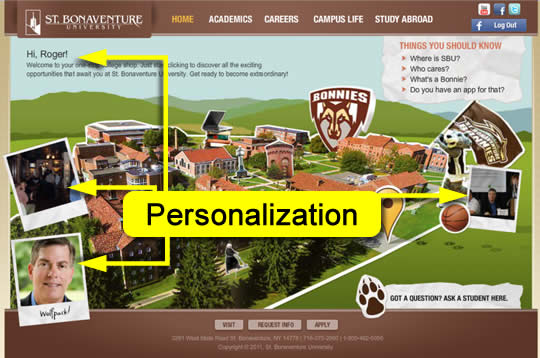 That’s just the start, though. If you click around the site, most of the content isn’t personalized, but every now and then something suprising pops up. For example, if you click on the location icon, the site uses the Facebook info to determine your start point:
That’s just the start, though. If you click around the site, most of the content isn’t personalized, but every now and then something suprising pops up. For example, if you click on the location icon, the site uses the Facebook info to determine your start point: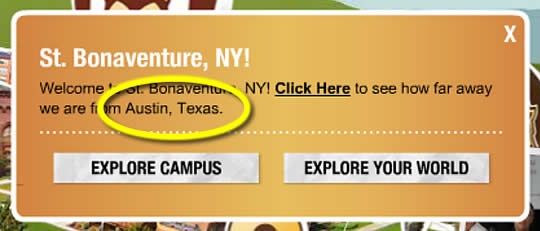 Another unexpected find is on the Academics tab, where the site grabbed my high school info (cleverly ignoring my undergrad and B-school data) to personalize a popup:
Another unexpected find is on the Academics tab, where the site grabbed my high school info (cleverly ignoring my undergrad and B-school data) to personalize a popup:
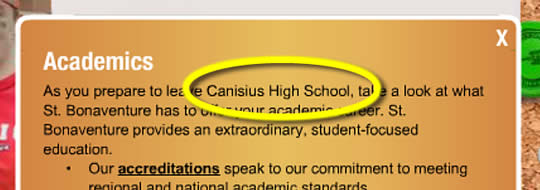
I almost missed what turned out to be my favorite personalizaton “easter egg” – 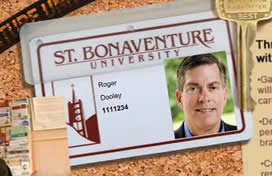 on a whole-page corkboard, there’s a St. Bonaventure student ID with my photo and name! This is the kind of visual imagery that can create a brand preference (see Social Personalization and the Doppelganger Effect.)
on a whole-page corkboard, there’s a St. Bonaventure student ID with my photo and name! This is the kind of visual imagery that can create a brand preference (see Social Personalization and the Doppelganger Effect.)
Some might find the personalization a little too subtle, but I think the fact that it’s not as obvious may actually make the site more engaging. Each time I spotted one of these little elements, I experienced a little “aha!” discovery moment. I was encouraged to poke around for more.
Is Psychology in Your Future?
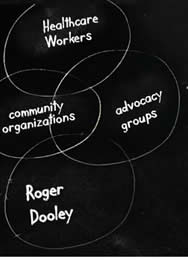 Sometimes, it may not be practical to require users to connect with Facebook, Twitter or other network. Users are understandably concerned about providing third-party access to their information, and may be reluctant to do so unless their is a strong motivator or a high degree of trust. If demanding a Facebook or other connection would depress the number of users who opt for enhanced interaction, simply getting a name can be sufficient.
Sometimes, it may not be practical to require users to connect with Facebook, Twitter or other network. Users are understandably concerned about providing third-party access to their information, and may be reluctant to do so unless their is a strong motivator or a high degree of trust. If demanding a Facebook or other connection would depress the number of users who opt for enhanced interaction, simply getting a name can be sufficient.
For example, this personalized video generator for the Adler School of Professional Psychology needs only the student’s name to build the student into the short video in a variety of creative ways.

See how you’d look as a future psychologist here.
If you quack like a duck…
 The University of Oregon takes a different approach by featuring the prospect as the school’s mascot, a duck. The video demonstrates some other interesting forms of interactive personalization. One of the most clever is what appears to be a page from a dictionary that builds the prospect’s name into the definition of “duck.” At another point, video from a Duck football game is displayed while the prospect’s name appears in a crawl display at the bottom of the screen. Become a Duck here.
The University of Oregon takes a different approach by featuring the prospect as the school’s mascot, a duck. The video demonstrates some other interesting forms of interactive personalization. One of the most clever is what appears to be a page from a dictionary that builds the prospect’s name into the definition of “duck.” At another point, video from a Duck football game is displayed while the prospect’s name appears in a crawl display at the bottom of the screen. Become a Duck here.
Note the difference in approach between the two videos. Adler uses personalization in an aspirational, career-oriented way; the prospect can visualize himself helping others, holding a prestigious position, etc. Oregon, in contrast, places the prospect in the university community, with the Duck mascot, the big-time sports references, and visual gags emphasizing that the school would be a fun place to spend four years. Even though neither exploits the photo-based Doppelganger effect, they do provide frequent “payoffs” to the viewers and should hold their attention far better than a typical promotional video.
According to my friend Chris Zahumensky, sales VP at Hobsons (the firm that created these campaigns), higher ed clients report significantly higher engagement with personalized websites, resulting in more inquiries and applications compared to traditional static web content.
Get Schooled
These examples are all from the higher ed area, but many businesses can learn from the diverse examples offered here. Social personalization offers some very powerful options, and even traditional name personalization can be transformed from boring to cool with today’s technology. If you aren’t putting your customer into your marketing, you’re missing an opportunity to increase conversion.
[Note: Neuromarketing readers may have noticed that I write about higher ed marketing, college branding, and related topics fairly often. I have a special interest in that area, as eleven years ago I co-founded College Confidential, now the busiest college-bound website. CC was acquired by Hobsons, a unit of DMGT, in 2008. Since Hobsons is a major provider of student recruitment help to colleges and universities, I’ve had a chance to see not just the student/parent side of things, but also the school side. All of these examples are from the Hobsons portfolio.]
